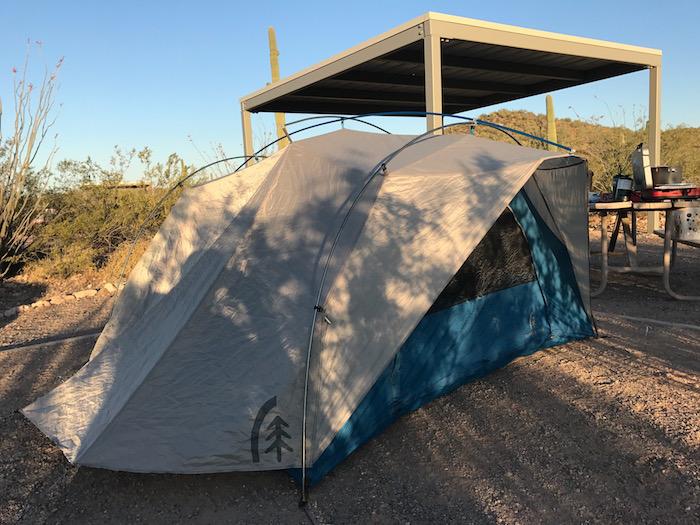
The Twin Peaks Campground at Organ Pipe Cactus National Monument offers sun shades along with picnic tables for each site, and restrooms with solar showers/Kurt Repanshek file
Editor's note: Will the year-end months here, where can you find some comfortable camping in the National Park System? We pulled Jim Burnett's story on that topic from the Traveler's archives for your consideration.
The arrival of fall signals the annual shutdown of campgrounds in some parks so facilities can be readied for the coming winter, but in other areas, the prime season for camping is here—or coming soon.
For most visitors, summer is just too hot for pleasant camping in some parts of the country, but late fall and early winter can be the best time of the year in many of those areas. Opinions vary about what constitutes "comfortable weather," so check the current forecast before you hit the road for the following parks.
That said, here's a sampling of several parks where the late fall and winter is prime time for outdoor activity.
Joshua Tree National Park in California has nine campgrounds, and several which are closed during the period of low summer visitation reopen on October 1.
The park website has details about each campground, including the number of sites, elevation, and perhaps most important in a desert park, locations where water is available. You'll also find information about which campgrounds accept advance reservations, and which are first come, first served.
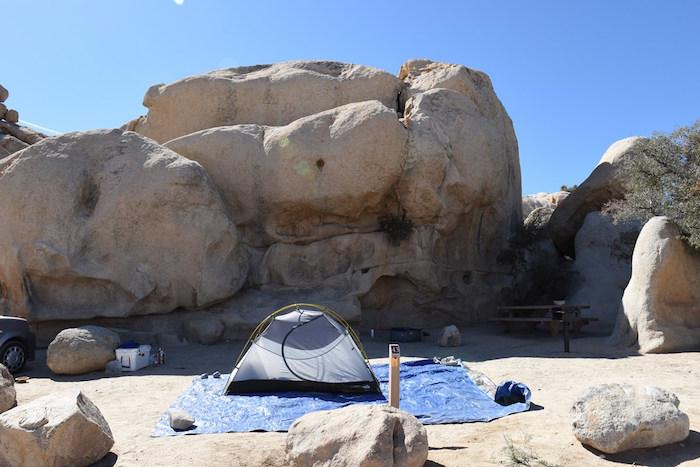
A campsite at the Hidden Valley Campground at Joshua Tree NP/NPS
Backcountry campers have lots of options at Joshua Tree, which the park describes as "a backpacker’s dream with its mild winter climate and interesting rock formations, plants, and wildlife. Click here for important details for backcountry use in the park.
Lake Mead National Recreation Area, on the Arizona-Nevada border south of Las Vegas, includes two large lakes and seven developed campgrounds: five on Lake Mead and two on Lake Mohave.
Although campgrounds in the park are open all year, the climate is much more pleasant in the fall and spring. NPS campgrounds offer restrooms, running water, dump stations, grills, picnic tables and shade; RV's, trailers and tents are welcome. Concessioner-operated campgrounds with recreational vehicle hook-ups are also available within the park. If you want a more rustic experience, numerous backcountry areas can be reached by boat, car, backpacking or horseback.
Organ Pipe Cactus National Monument is located in southern Arizona, right on the border with Mexico. The Twin Peaks Campground has 208 sites, can accommodate RVs up to 40 feet in length, and reserves some sites for tent camping only. It's a clean, comfortable campground, with water spigots every few campsites. There are solar showers in the restrooms, but be cautious, as the water can get searing hot on hot days.
Tenters looking for a more primitive experience may want to consider the very small Alamo Canyon campground. Motorhomes and trailers are not permitted at Alamo Canyon, camping in that location is by permit only; ask for one at the Kris Eggle Visitor Center before occupying a campsite. Sites are assigned on a first come, first served basis.
While backpacking treks are permitted in Organ Pipe, staff note that, "Be aware of your surroundings and do not leave belongings unattended. Illegal border activities do occur in Organ Pipe including smuggling of drugs and humans. Though smugglers and migrants want to evade detection, overnight travel/activity increases your risk of encountering illegal activity." Details on the park's backcountry "zones" and capacities can be found here.
Big Bend National Park in Texas offers three developed campgrounds that vary widely in suitability for various types of vehicles, and in elevation and climate.
The 60-site Chisos Basin Campground is
rugged and hilly. The sites are small and most are not suited to recreational vehicles or trailers. The road to the Basin is steep and curvy, especially at Panther Pass—the road’s highest point. The road into the campground is a 15 percent grade. Trailers longer than 20 feet and RVs longer than 24 feet are not recommended.
The elevation in the Basin is 5,400 feet, so it can get chilly here, and this part of the park can receive some winter snow, so many visitors prefer this location for summer, fall and spring.
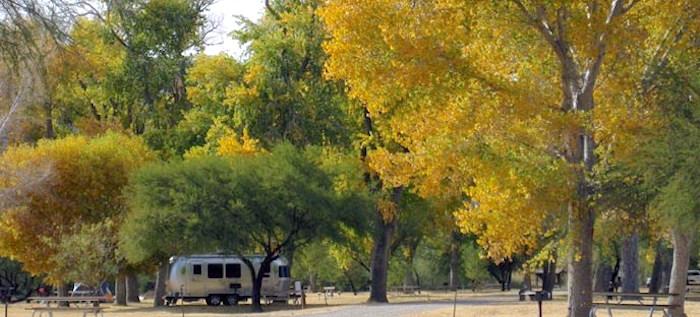
The Cottonwood Campground at Big Bend can make a great fall basecamp/NPS
If you're looking for milder late fall and winter weather, Cottonwood campground has 31 campsites near the Castolon Historic District, and is located near the Rio Grande at an elevation of 1,900 feet. The campground has pit toilets and potable water, but no hookups or dump station. RV users take note: the use of generators is not allowed in Cottonwood Campground.
Rio Grande Village is the park's largest developed campground, with 100 sites set in a large grove of cottonwoods adjacent to the Rio Grande.
Camping is also available at primitive backcountry campsites in the Chisos Mountains and along backcountry roads. High clearance or 4-wheel drive vehicles are necessary to reach most road sites. Big Bend's unpaved roads are generally unsuitable for RVs and trailers (check current conditions with a ranger). Overnight camping in any of the primitive road sites requires a backcountry use permit.
You'll find necessary details about backcountry use at this link.
Further downstream on the Rio Grande, in the vicinity of Del Rio, Texas, Amistad National Recreation Area offers four small campgrounds with the basics. All sites include covered picnic table and a BBQ grill, but only the Governors Landing campground has potable water.
Some parks are often still too warm even in the fall, so they are best suited for winter camping. Here are several suggestions for those of you who like to plan ahead.
Death Valley National Park is probably the ultimate example of extreme summer weather in this country, but the park website notes,
In contrast to the extremes of summertime, winter and spring are very pleasant. Winter daytime temperatures are mild in the low elevations, with cool nights that only occasionally reach freezing. Higher elevations are cooler than the low valley.
Note that the park's description mentions the mild winter weather; the forecast for Furnace Creek for the coming week includes some days with highs in the upper 90s. You may want to wait until November or later, when weather is typically more moderate, before making plans to pitch your tent in lower elevations at Death Valley. This page on the park website includes information on typical weather in the park, plus a link to the current forecast.
There are nine campgrounds in the park with varying facilities and seasons. The low elevation campgrounds, with the exception of the Furnace Creek Campground, close during the long summer months because of the extreme heat. Several higher elevation campgrounds remain open year round.
Want a less structured camping experience? There are ample opportunities in the park's backcountry.
Death Valley National Park's backcountry has a variety of rugged mountain and desert terrain. More than 3 million acres of wilderness and over 400 miles of backcountry dirt roads are open to camping.
Death Valley includes some of the most remote—and unforgiving—terrain in the Lower 48, so it's important to check the regulations and other important information on the park website as part of your planning for those trips.
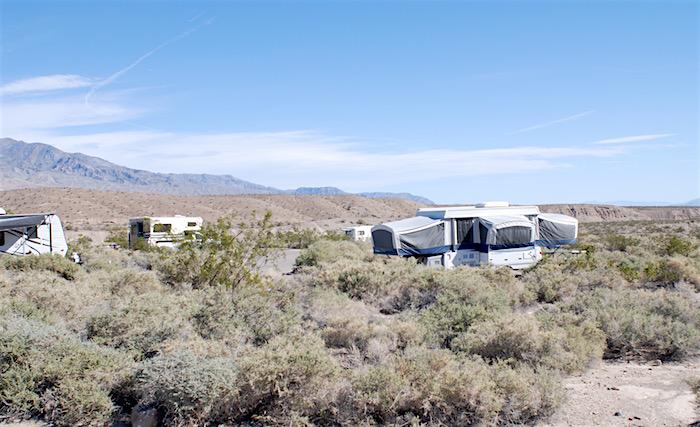
There's lots of room at the Mesquite Campground at Death Valley, but not much shade/Kurt Repanshek file
What about the eastern half of the country? As winter draws nearer, southern Florida sounds attractive to many people from colder climes, but you might want to wait a while longer before packing your camping gear and heading for the Everglades or Biscayne National Park.
Information from Everglades National Park describes the park's "wet season" (May-November) and "dry season" (December-April). Unless you're a veteran traveler to this part of the country, or have an affinity for heat, humidity and insects, I'd strongly suggest you check the details at those links before planning to camp in this area between May and November!
Everglades offers two developed campgrounds. Long Pine Key has 108 drive-up sites for tents and RVs, including one group site. There are rest rooms, water, and a sewer dump station with fresh water fill, but no showers or hookups. Sites at Long Pine Key are currently on a first-come basis.
Flamingo Campground is located at the end of the main park road. It
has 234 drive-in sites (55 with a view of the water), 3 walk-up group sites (on the water's edge), and 40 walk-up sites (9 on the water's edge). It also provides cold water showers, two dump stations, picnic tables, grills, and an amphitheater for winter programs. There are no hookups. Reservations can be made for some of the sites at Flamingo; click here for a link and more details.
Everglades also offers plenty of opportunities for backcountry camping.
Backcountry camp sites provide the perfect opportunity to experience the vast wilderness of the Everglades. Visitors can select between a variety of ground sites, beach sites and elevated camping platforms (sometimes called chickees). Most sites are accessible by canoe, kayak or motorboat, though a few may be reached by hikers. Visitors should be aware that none of the park's 47 backcountry sites are available by car.
If you're interested in backcountry camping in the Everglades, be sure to check the park website for important details, including permit requirements and essential trip planning information.
Not far from the Everglades is Biscayne National Park, which offers two campgrounds--but you can't drive or walk to either of them.
Both are located on islands, and the only access to these islands is by boat. Private boats can access the campgrounds year round. During the winter and spring, the park's concessioner provides access to the islands for a fee. To arrange for transportation to the island with the park's concessioner, call 305-230-1100.
It's always good to keep in mind that the weather can vary considerably from year to year and day to day in any part of the world, so a check of the current forecast before heading out on a trip can reduce the chance of an unpleasant surprise.
Fall and winter are my favorite times to visit the parks described above, but don't take the weather for granted any season of the year. I've seen rain in Death Valley, snow at Lake Mead and blue summer skies in the Hoh rain forest at Olympic, so the key is to check the forecast—and then be prepared for the unexpected when it comes to the weather!
The above sites are just a sampling of possibilities for fall and winter camping. What are your favorite NPS areas for that activity?

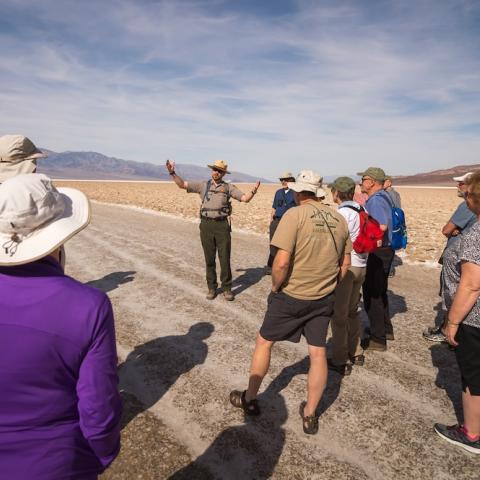
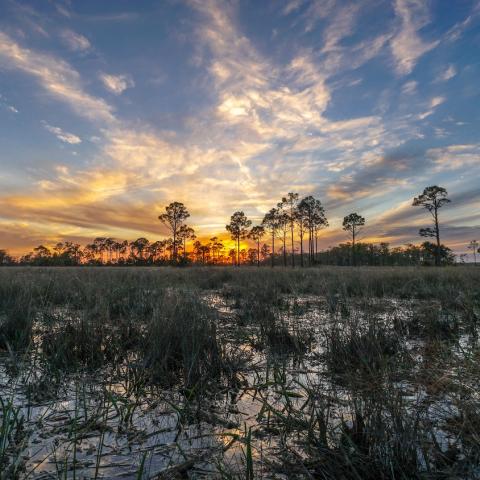

 Support Essential Coverage of Essential Places
Support Essential Coverage of Essential Places







Add comment